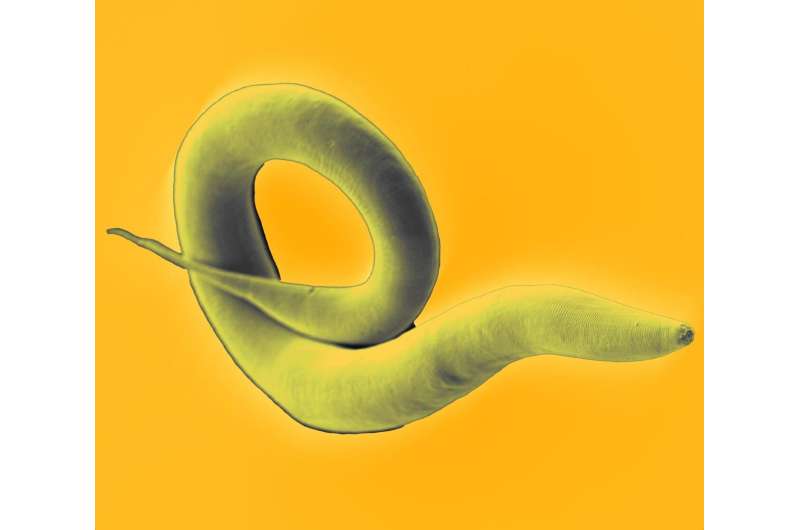Worms learn how to optimize foraging by switching their response to social cues

Researchers have shown how worms learn to optimize their foraging activity by switching their response to pheromones in the environment, according to a report published today in eLife.
The findings are an important advance in the field of animal behavior, providing new insights on how sensory cues are integrated to facilitate foraging and navigation.
Foraging food is one of the most critical yet challenging activities for animals, with food often patchily distributed and other animals trying to find and consume the same resources.
An important consideration is how long to stay and exploit a food patch before moving on to find another. Leaving incurs the cost of exploring a new territory, whereas staying put means feeding in a patch where resources are depleting. So how do animals know when to leave?
Natural habitats are usually full of chemical cues, such as pheromones from other individuals, and it is thought that pheromones help animals orientate their search for food. This means they need to know whether pheromones point to an abundant food resource, or an already exploited one. To acquire this knowledge, they need to learn from experience.
"It has been shown that bumblebees learn from the positive or negative association with pheromones acquired from their most recent feeding experience, but whether this is the case for other animals is unclear," explains first author Martina Dal Bello, Postdoctoral Associate at the Massachusetts Institute of Technology (MIT), Cambridge, US. "We wanted to investigate the foraging behaviors of Caenorhabditis elegans worms because we know that they can evaluate population density inside food patches using pheromones, and that both pheromones and food availability control when the worms decide to move on to a new food resource."
The team started with a test to assess the worms' patch-leaving behavior. Worms fed on a small patch of bacteria for about five hours, at equal distance from two spots: One a blend of pheromones and the other a non-pheromone control. The worms left the original patch at very different times; those that left early were more likely to go to the pheromone spot, whereas those that left late avoided the pheromones.
Next, they wanted to test whether these behaviors provided any survival benefits, so they developed a mathematical model to calculate the benefit to the worms of changing their preference for pheromones in a patchy environment. In the model, worms in an already occupied food patch have three choices: Remain in their food patch, switch to another occupied food patch, or disperse away to an unoccupied patch. The model showed that the strategy that maximizes the food eaten by a worm aligns with what they observed in the previous experiment. A fraction of worms switch at the beginning, leaving the food patch before it is depleted and following pheromones to reach another occupied patch. Then, once the food patches are depleted, all worms will disperse to find other food sources. These late leavers avoid other depleted patches by reversing their preference for pheromones, because they now associate pheromones with a depleted food patch.
So how do the worms know to reverse their preference for pheromones? To find out, the researchers kept worms in four sets of conditions: One with food and pheromones; one with pheromones but without food; one with food but without pheromones; and one without any food or pheromones. They then monitored how the worms reacted to a blend of pheromones. As anticipated, worms that spent time in the presence of both food and pheromones moved towards the pheromone blend, whereas they avoided it if they were used to the environment with pheromones but without food. As with bumblebees, the worms learn to prefer pheromones based on their recent positive or negative experience with foraging.
"Our study explains why worms tend to leave food patches at different times," explains senior author Jeff Gore, Professor of Physics at MIT. "Those that leave early are exposed to pheromones when food is abundant and have a positive association with these cues, which leads them to seek them out again. By contrast, worms that leave later when food is sparse associate pheromones with being famished, and avoid pheromones when they move away from the patch. Taken together, these results show that worms learn to adapt to sensory cues in their environment to optimize food intake during foraging."
More information: Martina Dal Bello et al, Inversion of pheromone preference optimizes foraging in C. elegans, eLife (2021). DOI: 10.7554/eLife.58144
Journal information: eLife
Provided by eLife





















